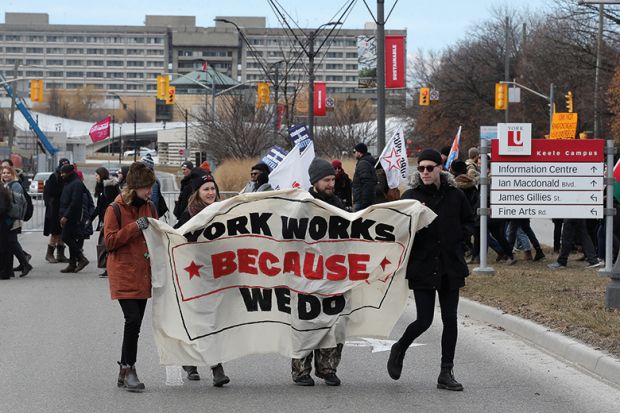A long-running industrial dispute at a Canadian university, where junior academics have been on strike since March, is a “harbinger of things to come” on campuses across North America if precarious employment contracts are not tackled, sector leaders have been warned.
About 3,000 casual academics and teaching and research assistants at York University in Toronto have manned picket lines since 5 March to protest against job insecurity at the institution.
The local branch of the Canadian Union of Public Employees, which organised the strike action, has called for longer contracts and more full-time opportunities for casual staff, year-round funding for teaching and graduate assistants – many of whom are not paid over the summer – and more job opportunities for master’s students.
CUPE said that the number of casual academics at York University has increased by 121 per cent since 2000, while the number of tenured professors has risen by just 20 per cent over the same period.
On 29 May, the dispute became the longest strike at an English-speaking university in Canada, exceeding the 85-day record set by York in 2008-09, when the same workers walked out. While the Ontario government introduced a back-to-work bill in early May, which would have forced an end to the strike, parliament dissolved for upcoming elections before the legislation could be passed.
More than half of all courses at the institution are estimated to be on hold as a result, and students who are due to graduate this year have been given provisional final grades but will need to finish their degrees once classes are resumed.
David Robinson, executive director of the Canadian Association of University Teachers, said that there was an “ongoing crisis within academic staffing within North America” resulting from the “increasing reliance upon contract labour”. He said he hoped that the strike at York would “register with policymakers” and prompt “a conversation about what’s happening in terms of employment at universities, what the impact is and how we can resolve it”.
“This, I think, is just a harbinger of things to come if we don’t resolve these issues,” Mr Robinson said. “When more and more academics are in a precarious position, they’re going to take desperate measures, and I think that’s the reason why we’re seeing strikes like this last longer and longer.”
Julian Arend, an executive committee spokesman for the CUPE branch involved in the strike, said that the action at York was “part of a broader movement” and a sense that “enough is enough in the sector” when it comes to job insecurity.
“We hope that by not giving in at least we are providing some sort of bolster [to other academics] for their own struggles,” he said.
But Rafael Gomez, director of the Centre for Industrial Relations and Human Resources at the University of Toronto, was not convinced that this marked the beginning of a trend of industrial action across Canadian universities.
He said that the current strike was part of “a pattern of a decade and a half of work stoppages” at York and that many other universities had different structures that reduced the likelihood of strikes.
“When you have this system, which in theory has no third-party arbitration but in practice ends up having it”, as has historically been the case at York, then the two parties take “extreme positions and don’t yield”, because there is a fear that an arbitrator will take the middle position, said Professor Gomez.
Register to continue
Why register?
- Registration is free and only takes a moment
- Once registered, you can read 3 articles a month
- Sign up for our newsletter
Subscribe
Or subscribe for unlimited access to:
- Unlimited access to news, views, insights & reviews
- Digital editions
- Digital access to THE’s university and college rankings analysis
Already registered or a current subscriber? Login










